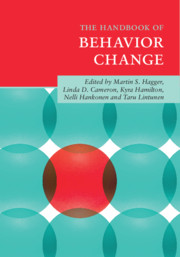Book contents
- The Handbook of Behavior Change
- The Handbook of Behavior Change
- Copyright page
- Dedication
- Contents
- Figures
- Tables
- Sidebars
- Contributors
- 1 Changing Behavior: A Theory- and Evidence-Based Approach
- Part I Theory and Behavior Change
- Part II Methods and Processes of Behavior Change: Intervention Development, Application, and Translation
- Part III Behavior Change Interventions: Practical Guides to Behavior Change
- 31 Attitudes and Persuasive Communication Interventions
- 32 Self-Efficacy Interventions
- 33 Imagery, Visualization, and Mental Simulation Interventions
- 34 Affect-Based Interventions
- 35 Autonomy-Supportive Interventions
- 36 Incentive-Based Interventions
- 37 Monitoring Interventions
- 38 Goal Setting Interventions
- 39 Planning and Implementation Intention Interventions
- 40 Self-Control Interventions
- 41 Habit Interventions
- 42 Economic and Behavioral Economic Approaches to Behavior Change
- 43 Dyadic Behavior Change Interventions
- 44 Social Identity Interventions
- 45 Motivational Interviewing Interventions
- 46 The Science of Behavior Change: The Road Ahead
- Index
- References
31 - Attitudes and Persuasive Communication Interventions
from Part III - Behavior Change Interventions: Practical Guides to Behavior Change
Published online by Cambridge University Press: 04 July 2020
- The Handbook of Behavior Change
- The Handbook of Behavior Change
- Copyright page
- Dedication
- Contents
- Figures
- Tables
- Sidebars
- Contributors
- 1 Changing Behavior: A Theory- and Evidence-Based Approach
- Part I Theory and Behavior Change
- Part II Methods and Processes of Behavior Change: Intervention Development, Application, and Translation
- Part III Behavior Change Interventions: Practical Guides to Behavior Change
- 31 Attitudes and Persuasive Communication Interventions
- 32 Self-Efficacy Interventions
- 33 Imagery, Visualization, and Mental Simulation Interventions
- 34 Affect-Based Interventions
- 35 Autonomy-Supportive Interventions
- 36 Incentive-Based Interventions
- 37 Monitoring Interventions
- 38 Goal Setting Interventions
- 39 Planning and Implementation Intention Interventions
- 40 Self-Control Interventions
- 41 Habit Interventions
- 42 Economic and Behavioral Economic Approaches to Behavior Change
- 43 Dyadic Behavior Change Interventions
- 44 Social Identity Interventions
- 45 Motivational Interviewing Interventions
- 46 The Science of Behavior Change: The Road Ahead
- Index
- References
Summary
Attitudes are people’s stored evaluations of entities (e.g., behaviors, people, ideas, objects). Attitudes are interesting from a behavior change perspective, given theory and research suggesting that attitudes guide behavior; thus, changing attitudes may be an effective means to change behavior. This chapter provides an overview of the attitude change literature and interventions targeting attitude change in order to change behavior. The chapter also provides example materials used in attitude-based behavior change interventions across a broad range of behaviors. First, the chapter provides an overview of the conceptualization and measurement of attitudes and the psychological theories that have been employed to explain how attitude change occurs. Next, research evidence of various attitude change techniques is reviewed, including information provision, communication-persuasion, and cognitive dissonance approaches. In addition, step-by-step instructions for select attitude change techniques are provided as templates for interventionists to formulate effective attitude change interventions. The chapter also provides a range of evidence-based materials that can be delivered in a variety of delivery modes (e.g., face-to-face, online, mass media). Finally, a review of the evidence on the effective implementation of these techniques is presented. The chapter concludes with a summary of the attitude change literature and presents some challenges and future directions in moving the attitude research forward.
Keywords
- Type
- Chapter
- Information
- The Handbook of Behavior Change , pp. 445 - 460Publisher: Cambridge University PressPrint publication year: 2020



